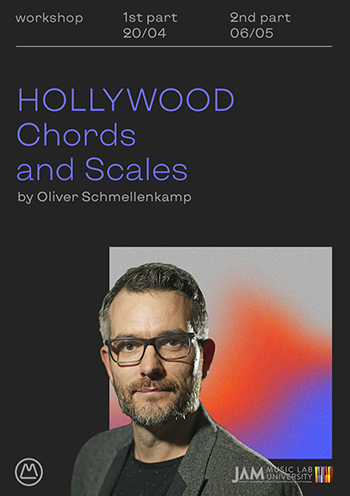
- днів
- годин
- хвилин
Workshop: HOLLYWOOD — CHORDS AND SCALES
Давно хотіли розібратися і відповісти на питання: як пишеться сучасна музика для кіно і чим цей підхід відрізняється від роботи з поп-музикою? Тоді на нашому дводенному майстер-класі, ми разом спробуємо знайти відповіді на більшість питань.
Лектор майстер-класу: Oliver Schmellenkamp
Oliver, є одним з провідних музичних композиторів Австрії, і викладачем Jam Music Lab University, Vienna. За його плечима великий досвід співпраці з міжнародними компаніями, брендами, медіа та ігровими компаніями серед яких: американські телеканали Fox, National Geographic, німецький ZDF, сотні саундтреків для Xbox і Nintendo, а так само бренди Pepsi, CocaCola, Ford, Boss, McDonald's, AirBerlin і багато інших.
Вас чекає:
2 заняття по 4 години
Дати: 20 апреля | 6 травня
Початок: 11: 00 - ранок
Формат: он-лайн
Обов'язково: виконання домашнього завдання
Мова майстер-класу: англійська
Кількість місць: 15
На цьому майстер-класі:
1. Прокачати знання в музичній теорії, емоційної і хроматичної гармонії і то, як застосувати це на практиці.
2. На час повернемося в минуле, до музики композиторів Штрауса, Вагнера і Стравінського, щоб подивитися, які прийоми можна запозичити у них і використовувати в наш час. Вивчимо підхід сучасних композиторів: Ханса Циммера, Макса Ріхтера і Стіва Яблонського і їх роботу з музичним матеріалом.
3. На прикладах відомих всім фільмів, серед яких: Зоряні Війни, Я робот, Мисливці за привидами, Прибуття і багатьох інших, ми дізнаємося, як за допомогою сучасного підходу до написання музики, використовуючи знання, отримані на курсі складати музичні ландшафти, які допоможу доповнити і розкрити події відбуваються на екрані.
Поки хтось мріє виграти "Оскар" і пише сценарій фільму - підтягни свої знання і напиши майбутній хіт в світі саундтреків. До зустрічі на майстер-класі!
Повна програма:
Warm-Up
I wouldn't say I like it when music theory turns into rocket science; I will keep it simple as far as possible. In the warm-up, we will talk about some basics that are important for this course.
Everything else I will explain (step by step) in the following chapters.
- Triads
- Scales
- Composers Piano
1. Emotional Harmony
This chapter takes an emotional look at the diatonic triads on the major and minor scales.
In examples from Hans Zimmer, Max Richter, Steve Jablonsky and Alan Silvestri, we cover how Diatonic Triads can be used to reach the listener's heart.
Composing with Major Scale
- Diatonic Triads
- Emotional Concept
- Harmonizing a Melody
Case Studies
- Gladiator
- Express
Composing with Minor Scale
- Diatonic Triads
- Emotional Concept
- Harmonizing a Melody
Case Studies
- Arrival
- Dark Knight
- Transformers
Orchestration/Scoring Tipp
To Picture
2. Magic Modes
The modes are an important part of a composer's toolbox; each mode represents its own world with its specific associations and narratives.
We have already discussed major and minor scales; now, let's look at the other modes.
We see examples from films like Da Vinci Code, Simpsons, Back to the Future, Indiana Jones and Star Wars.
The Lydian Mode - About fairytales and mermaids
- The Lydian scale and chords
- Composing with the mode
Case Studies
- Back to the Future
- Simpsons
- Universal Logo
- ET - Little Mermaid
The Dorian Mode - About pirates and the middle ages
- The Dorian scale and chords
- Composing with the mode
Case Studies
- American Beauty
- Star Wars
- Pirates of The Caribbean
The Phrygian Mode - About the desert and mummies
- The Phrygian scale and chords
- The Phrygian dominant scale
- Composing with the mode
- Double Harmonic
Case Studies
- The Mummy
- Lawrence of Arabia
- Stargate
The Mixolydian Mode - About crowdy city and mystical
- The Mixolydian scale and chords
- Mixolydian b13
- Composing with the mode
Case Studies
- Hotel For Dogs
- Ghostbusters?
- The Locrian Mode – Dark and Heavy
The Locrian scale and chords
- Mix the Modes
- it is possible to mix the modes or to move from one mode to another.
3. Chromatic
The chromatic harmony stands for the supernatural, the wonderful, the mysterious, the mystical and the fairytale,
and goes back to the composer of the 19th and 20th centuries like Mahler, Holst, Wagner, Strauss and Stravinsky.
We can put a major or minor chord on every step of the chromatic scale with this concept.
Chromatic Mediants
- Composing with Chromatic Mediants
- The Common Tone
Case Studies
- Atlantis
- iRobot
- Lord of The Rings
- Star Wars
- Orchestration/Scoring Tipp
- To Picture
- Tritone Relationship
- Composing with Tritone Related Chords
- Motifs and Melodies
Case Studies
- Indiana Jones
- iRobot
- Star Wars
- Orchestration/Scoring Tipp
- To Picture
Two Chord Relationships - The Shortcuts for Film Composer
- Chords and Narratives
I-I I-II I-III I-IV I-V I-VI I-VII
- String Theory
Case Studies
- Universal Logo
- iRobot
- Atlantis
4. Harmonic Direction
In film music, there are several possibilities to move from one chord to another. Each of these possibilities has its own sound.
- Progression
- Parallel
- Connection and Transformation
- String Theory
Orchestration/Scoring Tipp
- Developing melodies
- Motivic development
5. Chords and Colors
In this episode, we see which chords (besides triads) composers like John Williams, Danny Elfman and Bernard Hermann use,
to express different emotions.
- Hitchcock Chord
- The b13 Sound
- Cluster
- Poly Chords
- The Star Wars Chord
- John Williams Brass Triads
- Add Notes
- Compound Chords
- Diminished Transformation
- Pedals
6. Fancy Scales
Not only the modes are used by film composers, but other scales are used in certain situations. Here is a small overview.
- Synthetic Scales
- Octatonic
- Whole Tone
Case Studies
- Back to the Future
- Ghostbusters
